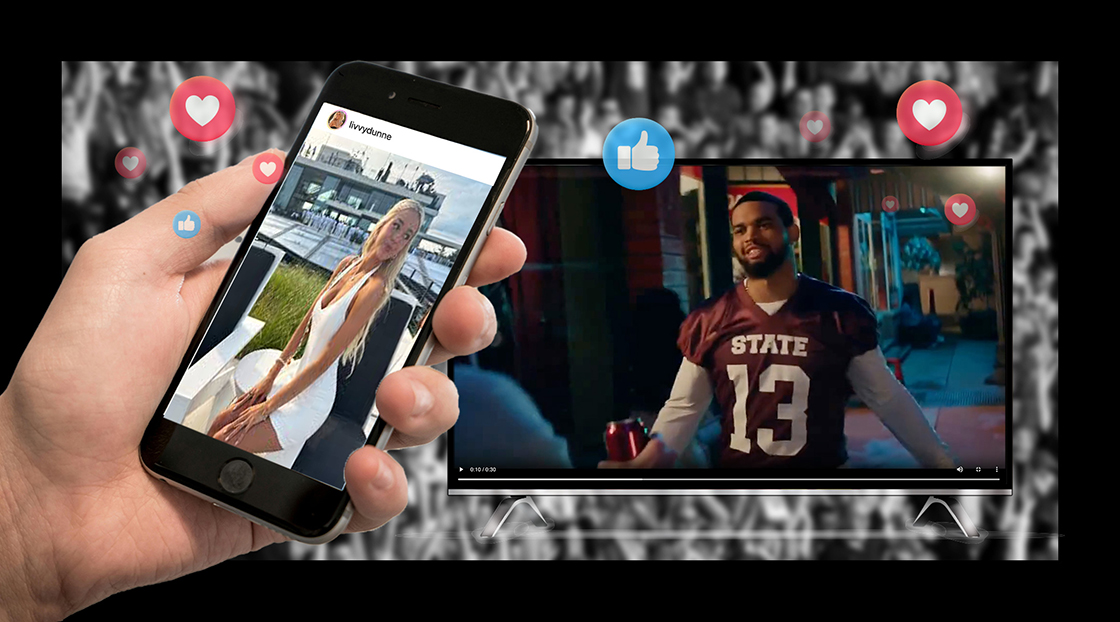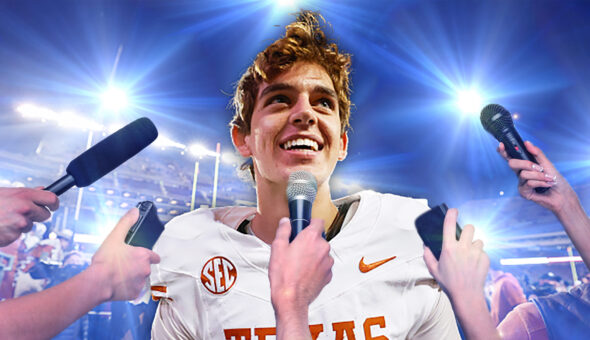For years, two archetypes were often painted about the experiences of college athletes.
The first went something like this: overworked student-athletes eating Ramen noodles and working side jobs at their college bookstores while the universities cashed in on their on-field successes, to the tune of billions of dollars.
That lived uncomfortably alongside the other: student-athletes (usually football and basketball players) at big-name schools driving luxury cars and wearing expensive jewelry no college kid could afford; where they got these things, nobody quite knew.
These two tales sketched the boundaries of an uncomfortable reality: Major college athletic programs raked in big dollars through the efforts of college athletes whose time on campus was predominantly spent working for their teams, though they could not legally be paid for those efforts beyond their tuition costs.
In July 2021, the Supreme Court ended that when it ruled the NCAA’s outright ban on student-athlete compensation was illegal. This paved the way for college athletes to earn money for their work by marketing their names, images and likenesses (NIL).
Now, a few thousand college and high school athletes make six figures yearly, and some three dozen are worth $1 million or more in annual endorsements.
Schools have long cashed in on their most marketable players, well before NIL gave athletes a piece of the money-windfall pie. But is there room for schools to also build on athletes’ success in ways they haven’t before? The success of LSU gymnast and social media influencer Livvy Dunne offers perhaps the greatest insight.
The Livvy Dunne Effect
Dunne, 21, has amassed 5.3 million followers on Instagram and 8.1 million followers on TikTok through a mix of gymnastics videos, lifestyle content and trendy posts, engaging with her followers through viral challenges and behind-the-scenes clips of her training, among other ways. Her social media fame has catapulted her NIL value to nearly $4 million annually and attracted the likes of Vuori, American Eagle, Bodyarmor and Grubhub to hire her as a sponsor. She is estimated to rank second among the highest paid NIL athletes, behind University of Colorado quarterback Shedeur Sanders.
“There’s a lot of indirect benefits and all of a sudden it’s started to make everything else a lot better for schools and their ability to generate revenue.” — Brennan Berg, associate professor at the University of Mississippi
Dunne can’t wear LSU gear in her brand-sponsored ads due to licensing restrictions. But her organic social media following and skyrocketing fame in pop culture (she’s dating Major League Baseball rookie phenom Paul Skenes) has led to new recognition for both LSU and its gymnastics team.
In April, the Lady Tigers won their first-ever national championship in the sport and led the country with an average of 12,500 tickets sold for each home match at the school’s Pete Maravich Assembly Center — a 13,000-person-capacity arena normally used for basketball. Also for the first time in school history, the gymnastics team sold out its allotment of season tickets.
View this post on Instagram
“NIL has brought attention and tangible value to the university’s brand,” explained Michael Hutchinson, a professor of sport commerce at the University of Memphis. “It allows athletes to contribute through the exposure they historically wouldn’t have had any chance at providing, especially in ‘non-revenue’ sports outside of football and basketball.”
Hutchinson, who’s published a number of peer-reviewed articles in academic journals during his 12 years teaching sports commerce at Memphis, said Dunne’s example is a blueprint for athletes, who normally wouldn’t have been significant in the public eye, now making major contributions not just to their sport’s success but also their university’s branding.
“The athletes understand that no third party is going to want to work with them if they present themselves in a very irresponsible way.” — Brennan Berg, associate professor at the University of Mississippi
In addition to the record gymnastics turnouts, LSU’s undergraduate applications have continued a linear climb to new records each of the four years that Dunne has been at the university. Hutchinson said it would be “difficult” to attribute the application and enrollment gains directly to Dunne or even suggest she’s had a major influence on them. But when many U.S. schools are seeing enrollment numbers nosedive amid a population cliff, athletes like Dunne are certainly contributing in some form to LSU’s upward trajectory.
“Some sports are easily marketable but others are more marketable when you have people who are known because of social media,” Hutchinson said. “NIL has made athletes more prominent because they’re making money and are motivated to connect with people and brands that they had not been able to in the past.”
Read more: How to prepare for the TikTok ban
The Memphis professor added that Dunne “absolutely gives LSU a competitive advantage” in marketing both its gymnastics program and, to a certain extent, the university as a whole.
“For schools that have someone with seven-figure followers with that kind of reach locally, nationally and internationally, why would they not do what they could to market that like football or basketball?”
Who is the audience for NIL sponsorships?
But who exactly are NIL athletes reaching? According to interviewed scholars, it really depends.
In Dunne’s case, Hutchinson noted it’s mostly younger people from Gen Z and Gen Alpha who may prefer social media over traditional ad outlets like newspapers, radio, television and billboards. For other athletes, especially in more-popular sports, the advertising outlet could matter most.
Case in point: When former USC Trojans quarterback Caleb Williams and current Texas Longhorns quarterback Quinn Ewers star in Dr. Pepper commercials set in a fictional football-crazed town called Fansville, casual viewers might not instantly recognize their faces or immediately connect them with their schools. After all, Williams and Ewers don’t wear their universities’ logos in the commercials or make any mention of where they play.
But for people versed in football, especially high school athletes debating which school to choose for their college-sport career, such ads can be powerful recruiting tools.
“I think the benefit is ‘Oh, Caleb Williams is in a commercial; I’m a 5-star quarterback thinking of where to play, and I see USC and Texas have their quarterbacks in ads and Michigan doesn’t,” said Tarun Sharma, adjunct professor in the University of Minnesota Law School. “So I’m thinking I’d be better off going to one of these schools that’s going to give me a better platform.”
Sharma in 2022 founded Minnesota’s NIL Clinic to offer pro-bono legal services to college athletes across the country in managing their sponsorship offers. While most major-sport athletes like Williams or well-known athlete influencers like Dunne normally have their own agents and a team of lawyers already behind them, Sharma’s NIL clinic aims to serve lesser-known athletes in handling smaller, one-off deals. He gave the example of a women’s hockey player who gets a direct message on Instagram after a big game to post once about a clothing brand.
“We review the contracts for them and make sure that they’re aware of the compliance requirements, making sure they know exactly what they’re signing up for, know how they’re getting paid, what they’re going to be paid and when,” he said. “We represent a very distinct class of athletes.”
The maturity factor and staying on campus
One of the greatest benefits of NIL that universities can leverage and that parents can celebrate is a documented increase in maturity from young athletes across the country. Brennan Berg, associate professor at the University of Mississippi and director of the school’s sport and recreation administration program led two major studies published in the Journal of Issues in Intercollegiate Athletics that suggest, in part, that students feel more accountable and responsible when their off-the-field behavior impacts their bottom line.
Listen: How Butler University’s basketball program built a marketing powerhouse
Berg argues NIL helps students mature at an earlier age when they realize posting “garbage” on social media or making headlines for the wrong reasons will turn sponsors away.
“They understand that no third-party is going to want to work with them if they present themselves in a very irresponsible way,” Berg said. “So more schools are avoiding off-the-field, out-of-competition issues or disciplinary issues. And that benefits everyone involved.”
NIL has also kept more students on campus in recent years, simply because the earning opportunity for many student-athletes is higher than as a pro. That holds true for some athletes in major sports and in smaller ones, like gymnastics, where professional leagues are either in the fledgling stage or non-existent altogether. LSU’s Dunne, who’s returning for a fifth season, University of Kansas basketball star Hunter Dickinson — a dominant college player whose style of play doesn’t project to success as a pro — and countless college football players are prime examples of how NIL has kept marketable names and faces on campus longer than they’d have stayed in the pre-NIL era.
“In turn, the hype impacts schools’ ticket sales revenue and how much they can charge sponsors to market their products,” Berg said. “There’s a lot of indirect benefits and all of a sudden it’s started to make everything else a lot better for schools and their ability to generate revenue.”









